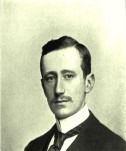Things To Make by Archibald Williams is part of the HackerNoon Books Series. You can jump to any chapter in this book here. A SILHOUETTE DRAWING MACHINE
XXXVII. A SILHOUETTE DRAWING MACHINE.
With this very simple apparatus you will be able to give good entertainment to such of your friends as may wish to have black paper records of their faces in profile.
The machine is merely a long rod, with a sliding pencil attached to one end and a metal pointer stuck into the other, supported near the pencil end on a pivot which permits free movement in all directions.
For heads and busts only, the rod and pointer combined need not be more than 4 feet 6 inches long. The rod is a 1/2-inch blind rod, the pointer a stout knitting-needle driven axially into one end of the rod. This pointer, being of small diameter, follows the minor curves and angles of the features much more closely than would be possible with the rod.
The support is a piece of wood, 1-1/2 inches square and 12 to 15 inches long, screwed on to a large foot, which should be fairly heavy, as any tilting or slipping will, of course, spoil the silhouette. The universal joint for the rod is made by soldering a small U-shaped piece of metal to the end of a short metal bar. The ends of the U are drilled for a pin passing through the rod; and a hole is sunk into the top of the support to take the bar. The fit should be close, to prevent the pivot rocking about, and the hole in the support deep enough to bring the bottom of the stirrup down against the wood.
If a series of holes half an inch apart is drilled, through the rod, the nearest 9 inches from the pencil end, the size of the silhouette proportionately to the original can be varied by moving the pin from one hole to another.
[Illustration: FIG. 188.—Silhouettograph in use.]
[Illustration: FIG. 188a.—Group of silhouettes drawn with the machine described.]
The pencil holder is 4 inches of tubing, in which the pencil can slide easily without shaking. If necessary, the size of the pencil should be reduced by rubbing with glass paper. Bind the holder tightly to the end of the rod away from the pointer, so that one extremity just overhangs the rod. A piece of thin elastic is tied to the unsharpened end of the pencil and to the pencil tube, the adjustment allowing the pencil to project an inch when the elastic is taut but not stretched.
A fairly soft pencil and a thick, smooth paper or card give the best results. Paper should be backed by something hard to prevent the pencil digging in. Attach the paper to a firm vertical surface, such as the side of a box, a drawing board, a wall, etc.
Using the Machine.—The rod support, paper, and sitter should be arranged so that the rod is level at the height of the sitter’s nose and the pencil on the centre of the paper. Bring the support near enough to the paper to drive the pencil back into the tube until the point projects only half an inch.
A thread attached to the pencil will enable you to keep the pencil off the paper until you wish to begin drawing the profile.
Begin with the pointer pressing against the sitter’s chest, and bring it over the face and down the back of the head and neck. Do not press it into the hair, but carry it along what you consider to be the outline; though it must be in actual contact with the features and clothes. It is hardly necessary to mention that the sitter must keep perfectly still if the silhouette is to be at all accurate.
The tracing is cut round with fine-pointed scissors, and the paper blacked and stuck on a piece of white card. Some trouble is saved by using paper white on one aide and black on the other. If duplicates are needed, two or more pieces of paper should be stuck together by the corners and to the paper on which the silhouette is drawn, and all be cut through at one operation.
With a little practice the actual tracing of the outline occupies but a few seconds. Things are expedited if an assistant adjusts the paper and pencil.
About HackerNoon Book Series: We bring you the most important technical, scientific, and insightful public domain books.
This book is part of the public domain. Archibald Williams (2005). Things To Make. Urbana, Illinois: Project Gutenberg. Retrieved https://www.gutenberg.org/cache/epub/14664/pg14664-images.html
This eBook is for the use of anyone anywhere at no cost and with almost no restrictions whatsoever. You may copy it, give it away or re-use it under the terms of the Project Gutenberg License included with this eBook or online at www.gutenberg.org, located at https://www.gutenberg.org/policy/license.html.

